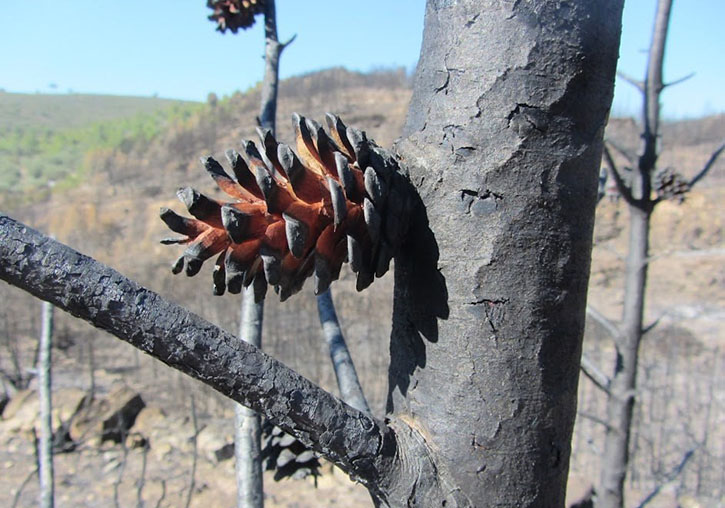
Un equipo del Centro de Investigaciones sobre Desertificación (CIDE, UV-CSIC-GVA) ha comprobado que, en lugares con incendios frecuentes, los pinos comienzan a reproducirse a edades más tempranas. Un mayor éxito reproductivo de los individuos precoces permite a las poblaciones de pino carrasco persistir en sitios que se queman con frecuencia. El trabajo aparece publicado en la revista Oikos.
Mediterranean ecosystems have coexisted with fire for millions of years. One of its most common inhabitants, the Aleppo pine (Pinus halepensis), has developed strategies to survive in this fire-prone environment. A research team from the Desertification Research Centre (CIDE), a mixed centre of the University of Valencia (UV), the Higher Council for Scientific Research (CSIC) and the Valencian Government, has verified in 13 locations in the Spanish Mediterranean that, in places that burn more frequently, pines start reproducing at earlier ages. The results have a direct application in forest management and restoration.
Pines reproduce sexually using structures known as cones. There are male and female cones, which are produced on the same tree on different branches. The male ones are much smaller than the female ones, and it is where the pollen grains that are released at maturity are formed. Production of female cones begins in winter, preparing the ovules for pollination the following spring. When the ovules are fertilised, the seeds are formed, which are protected inside the cone. These develop for two years, enlarge and harden, and become cones.
“Aleppo pine is a species that is very well adapted to fires”, says Carmen Guiote Mingorance, a CIDE researcher leading the study. “Although individuals die from fire, they leave behind a large number of offspring”, she describes.
For this strategy to be beneficial, individuals need to reach sexual maturity and start producing cones before the next fire breaks out. The age of first reproduction of the Aleppo pine is usually around 10-15 years, but it varies between individuals; the earliest can reproduce as early as 4 years.
The CIDE team wanted to verify the existence of earlier individuals in areas with very frequent fires, since those that have not reached sexual maturity cannot leave offspring after the fire. “To validate our hypothesis, we determined the age of the first reproduction and the number of cones accumulated by each pine tree in 13 locations in the eastern peninsula, the majority located in the Valencian Community, from Benicàssim to Xeresa”, recalls Juli Pausas, co-signer of the published article in Oikos. “In this area, lower altitude areas burn more frequently than higher altitude ones. These differences in the fire regime allowed us to prove that the populations historically subjected to more recurring fires begin their reproduction before those that have burned little”, he assures.
According to the CIDE team, these results have direct application in forest management and restoration. Knowing the variability of responses that species have in the face of fire offers the ability to act to manage landscapes and make them more resilient to the increase in fires.
Reference:
Guiote, C. and Pausas, J. G. (2022), Fire favors sexual precocity in a Mediterranean pine. Oikos e09373. https://doi.org/10.1111/oik.09373 (open acces)










